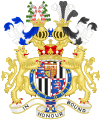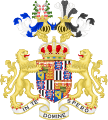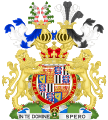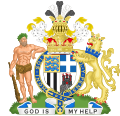Mountbatten family
This article has multiple issues. Please help improve it or discuss these issues on the talk page. (Learn how and when to remove these template messages)
|
| Mountbatten | |
|---|---|
| German-British noble family | |
 Blazon: Quarterly, 1st and 4th: Azure, a Lion rampant double-queued Barry of ten Argent and Gules and ducaly crowned Or, within a Bordure compony of the second and third (Hesse); 2nd and 3rd: Argent, two pallets Sable (Battenberg). | |
| Parent family | Battenberg branch of the House of Hesse-Darmstadt |
| Place of origin | Grand Duchy of Hesse |
| Founded | 14 July 1917 |
| Current head | George Mountbatten, 4th Marquess of Milford Haven |
| Titles |
|
| Connected members | |
| Connected families | |
| Cadet branches | |
The Mountbatten family is a British dynasty that originated as a British branch of the German princely Battenberg family. The name was adopted on 14 July 1917, three days before the British royal family changed its name from "Saxe-Coburg and Gotha" to "Windsor", by members of the Battenberg family residing in the United Kingdom, due to rising anti-German sentiment among the British public during World War I. The name is a direct Anglicisation of the German Battenberg, the name of a small town in Hesse. The titles of count and later prince of Battenberg had been granted in the mid-19th century to a morganatic branch of the House of Hesse-Darmstadt, itself a cadet branch of the House of Hesse.
The family includes the Marquesses of Milford Haven (and formerly the Marquesses of Carisbrooke), as well as the Earls Mountbatten of Burma. The late Prince Philip, Duke of Edinburgh, consort of Queen Elizabeth II, adopted the surname of Mountbatten from his mother's family in 1947, being a member of the House of Schleswig-Holstein-Sonderburg-Glücksburg by patrilineal descent. Lady Louise Mountbatten became Queen consort of Sweden after her husband King Gustaf VI Adolf ascended the Swedish throne 1950.
Origins[edit]
The Mountbatten family are a branch of the German house of Battenberg. The Battenberg family was a morganatic branch of the House of Hesse-Darmstadt, rulers of the Grand Duchy of Hesse in Germany. The first member of the House of Battenberg was Julia Hauke, whose brother-in-law Grand Duke Louis III of Hesse created her Countess of Battenberg with the style Illustrious Highness (HIllH) in 1851, on the occasion of her morganatic marriage to Grand Duke Louis' brother Prince Alexander of Hesse and by Rhine. Julia was elevated in her title to Princess of Battenberg with the style Serene Highness (HSH) in 1858.[1]
Two of Alexander and Julia's sons, Prince Henry of Battenberg and Prince Louis of Battenberg, became associated with the British Royal Family. Prince Henry married The Princess Beatrice, the youngest daughter of Queen Victoria. Prince Louis married Victoria's granddaughter, Princess Victoria of Hesse and by Rhine, and became the First Sea Lord of the Royal Navy. Due to anti-German feelings prevalent in Britain during World War I, Prince Louis, his children, and his nephews (the living sons of Prince Henry), renounced their German titles and changed their name to the more English sounding Mountbatten. (They rejected an alternative translation, "Battenhill".)[2] Their cousin George V compensated the princes with British peerages. Prince Louis became the 1st Marquess of Milford Haven, while Prince Alexander, Prince Henry's eldest son, became the 1st Marquess of Carisbrooke.[1][3]
Members[edit]
Marquesses of Milford Haven[edit]

The marquessate of Milford Haven was created in 1917 for Prince Louis of Battenberg, the former First Sea Lord, and a relation to the British Royal family. He was at the same time made Earl of Medina and Viscount Alderney, also in the Peerage of the United Kingdom.[3] Princess Alice of Battenberg never took the name Mountbatten as she married Prince Andrew of Greece and Denmark in 1903; her son, Prince Philip of Greece and Denmark, took the name upon becoming a naturalised British citizen.[4]
- Louis Mountbatten, 1st Marquess of Milford Haven (1854–1921) m. Princess Victoria of Hesse and by Rhine
- Princess Alice of Battenberg (1885–1969) m. Prince Andrew of Greece and Denmark, son of King George I of Greece
- Princess Margarita of Greece and Denmark (1905–1981) m. Gottfried, Prince of Hohenlohe-Langenburg
- Princess Theodora of Greece and Denmark (1906–1969) m. Berthold, Margrave of Baden
- Princess Cecilie of Greece and Denmark (1911–1937) m. Georg Donatus, Hereditary Grand Duke of Hesse
- Princess Sophie of Greece and Denmark (1914–2001) m. Prince Christoph of Hesse d. 1943, m. Prince George William of Hanover
- Prince Philip of Greece and Denmark (1921–2021), m. Elizabeth II of the United Kingdom
- Lady Louise Mountbatten (1889–1965) m. Gustaf VI Adolf of Sweden
- George Mountbatten, 2nd Marquess of Milford Haven (1892–1938) m. Countess Nadejda Mikhailovna de Torby
- Lady Tatiana Mountbatten (1917–1988)
- David Mountbatten, 3rd Marquess of Milford Haven (1919–1970) m. Romaine Dahlgren Pierce div. 1954, m. Janet Mercedes Bryce
- George Mountbatten, 4th Marquess of Milford Haven (b. 1961) m. Sarah Georgina Walker div. 1996, m. Clare Steel
- Lady Tatiana Dru (b. 1990) m. Alexander Dru
- Henry Mountbatten, Earl of Medina (b. 1991)
- Lord Ivar Mountbatten (b. 1963) m. Penelope Anne Vere Thompson div. 2011, m. James Coyle
- Ella Mountbatten (b. 1996)
- Alexandra Mountbatten (b. 1998)
- Louise Mountbatten (b. 2002)
- George Mountbatten, 4th Marquess of Milford Haven (b. 1961) m. Sarah Georgina Walker div. 1996, m. Clare Steel
- Louis Mountbatten, 1st Earl Mountbatten of Burma (1900–1979) m. Edwina Ashley
- Princess Alice of Battenberg (1885–1969) m. Prince Andrew of Greece and Denmark, son of King George I of Greece
The heir apparent to the marquessate is the present holder's son Henry Mountbatten, Earl of Medina (b. 1991)
The 1st Marquess's youngest daughter, Lady Louise Mountbatten, married the crown prince of Sweden in 1923. On his accession in 1950 as Gustaf VI Adolf of Sweden, Louise became Queen consort of Sweden.[5][6]
Earls Mountbatten of Burma[edit]

Earl Mountbatten of Burma is a title in the Peerage of the United Kingdom, created in 1947 for Rear Admiral Louis Mountbatten, 1st Viscount Mountbatten of Burma, youngest son of the 1st Marquess of Milford Haven and the last Viceroy of India. The letters patent creating the title specified the following special remainder to his daughters. The subsidiary titles of the Earldom are Viscount Mountbatten of Burma, of Romsey in the County of Southampton, created 1946, and Baron Romsey, of Romsey in the County of Southampton, created in 1947. Both of these titles, in the Peerage of the United Kingdom, have the same special remainder as the Earldom.[7]
- Louis Mountbatten, 1st Earl Mountbatten of Burma (1900–1979) m. Edwina Cynthia Annette Ashley, daughter of Wilfrid Ashley, 1st Baron Mount Temple and great-granddaughter of Anthony Ashley-Cooper, 7th Earl of Shaftesbury
- Patricia Knatchbull, 2nd Countess Mountbatten of Burma (1924–2017) m. John Knatchbull, 7th Baron Brabourne
- Norton Knatchbull, 3rd Earl Mountbatten of Burma (b. 1947) m. Penelope Eastwood
- Nicholas Knatchbull, Lord Brabourne (b. 1981)
- Lady Alexandra Hooper (b. 1982) m. Thomas Hooper
- The Hon. Leonora Knatchbull (1986–1991)
- The Hon. Michael-John Knatchbull (b. 1950) m. Melissa Clare Owen, div. 1997, m. Susan Penelope "Penny" Jane Coates, div. 2006
- Kelly Knatchbull (b. 1988)
- Savannah Knatchbull (b. 2001)
- The Hon. Anthony Knatchbull (1952–1952)
- Lady Joanna Zuckerman (b. 1955) m. Baron Hubert Pernot du Breuil, div. 1995, m. Azriel Zuckerman
- Baroness Eleuthera Pernot du Breuil (b. 1986)
- Alexander Zuckerman (b. 2002)
- Lady Amanda Ellingworth (b. 1957) m. Charles Vincent Ellingworth
- Luke Ellingworth (b. 1991)
- Joseph Ellingworth (b. 1992)
- Louis Ellingworth (b. 1995)
- The Hon. Philip Knatchbull (b. 1961) m. Atalanta Cowan, div. 2000, m. Wendy Amanda Leach
- Daisy Knatchbull (b. 1992)
- Phoebe Knatchbull (b. 1995)
- Frederick Knatchbull (b. 2003)
- John Knatchbull (b. 2004)
- The Hon. Nicholas Knatchbull (1964–1979)
- The Hon. Timothy Knatchbull (b. 1964) m. Isabella Julia Norman
- Amber Knatchbull (b. 2000)
- Milo Knatchbull (b. 2001)
- Ludovic Knatchbull (b. 2003)
- Isla Knatchbull (b. 2005)
- Wilhelmina Knatchbull (b. 2008)
- Norton Knatchbull, 3rd Earl Mountbatten of Burma (b. 1947) m. Penelope Eastwood
- Lady Pamela Hicks (b. 1929) m. David Nightingale Hicks
- Edwina Brudenell (b. 1961) m. Jeremy Brudenell, div. 2004
- Maddison Brudenell (b. 1994)
- Jordon Brudenell (b. 1995)
- Rowan Brudenell (b. 2001)
- Ashley Hicks (b. 1963) m. Marina Allegra Federica Silvia Tondato, div. 2009, m. Katalina Sharkey de Solis
- Angelica Hicks (b. 1992)
- Ambrosia Hicks (b. 1997)
- Caspian Hicks (b. 2018)
- Horatio Hicks (b. 2019)
- India Hicks (b. 1967) m. David Flint Wood
- Wesley Flint Wood (b. 1997) (adopted)
- Felix Flint Wood (b. 1997)
- Amory Flint Wood (b. 1999)
- Conrad Flint Wood (b. 2003)
- Domino Flint Wood (b. 2007)
- Edwina Brudenell (b. 1961) m. Jeremy Brudenell, div. 2004
- Patricia Knatchbull, 2nd Countess Mountbatten of Burma (1924–2017) m. John Knatchbull, 7th Baron Brabourne
The heir apparent to the earldom is the present holder's son, Nicholas Knatchbull, Lord Brabourne (born 1981).
Marquess of Carisbrooke[edit]

Marquess of Carisbrooke was a title in the Peerage of the United Kingdom, created in 1917 for Prince Alexander of Battenberg, eldest son of Princess Beatrice of the United Kingdom and Prince Henry of Battenberg. He was made Viscount Launceston, in the County of Cornwall, and Earl of Berkhampsted at the same time, also in the Peerage of the United Kingdom.[3] The titles became extinct upon Lord Carisbrooke's death in 1960, as he had no sons.
- Alexander Mountbatten, 1st Marquess of Carisbrooke (1886–1960) m. Lady Irene Denison, daughter of William Denison, 2nd Earl of Londesborough
- Lady Iris Mountbatten (1920–1982) m. Captain Hamilton Joseph Keyes O'Malley, div. 1946, m. Michael Neely Bryan, div. 1957, m. William Alexander Kemp
His siblings were:
- Princess Victoria Eugenie of Battenberg (1887–1969), m. Alfonso XIII of Spain
- Lord Leopold Mountbatten (1889–1922)
- Prince Maurice of Battenberg (1891–1914)
Prince Philip, Duke of Edinburgh[edit]

Prince Philip, Duke of Edinburgh, the son of Princess Alice of Battenberg and grandson of the 1st Marquess of Milford Haven, took the name Mountbatten when he became a naturalised British subject. Lieutenant Philip Mountbatten married Princess Elizabeth, daughter of King George VI of the United Kingdom, on 20 November 1947. In 1952, on the accession of his wife as Queen Elizabeth II, there was some dispute regarding the dynasty to which descendants of Elizabeth and Phillip would belong. Queen Mary (the new Queen's grandmother) expressed to Prime Minister Winston Churchill her aversion to the idea of the House of Mountbatten succeeding the House of Windsor as the royal dynasty, and so it remained Windsor.[4]
- Prince Philip, Duke of Edinburgh (1921–2021) m. Queen Elizabeth II of the United Kingdom
- King Charles III (b. 1948) m. Lady Diana Spencer, div. 1996, m. Camilla Parker Bowles
- William, Prince of Wales (b. 1982) m. Catherine Middleton
- Prince George of Wales (b. 2013)
- Princess Charlotte of Wales (b. 2015)
- Prince Louis of Wales (b. 2018)
- Prince Harry, Duke of Sussex (b. 1984) m. Meghan Markle
- Prince Archie of Sussex (b. 2019)
- Princess Lilibet of Sussex (b. 2021)
- William, Prince of Wales (b. 1982) m. Catherine Middleton
- Anne, Princess Royal (b. 1950) m. Captain Mark Phillips, div. 1992, m. Vice Admiral Sir Timothy Laurence
- Prince Andrew, Duke of York (b. 1960) m. Sarah Ferguson, div. 1996
- Princess Beatrice of York (b. 1988) m. Edoardo Mapelli Mozzi
- Princess Eugenie of York (b. 1990) m. Jack Brooksbank
- Prince Edward, Duke of Edinburgh (b. 1964) m. Sophie Rhys-Jones
- Lady Louise Mountbatten-Windsor (b. 2003)
- James, Earl of Wessex (b. 2007)
- King Charles III (b. 1948) m. Lady Diana Spencer, div. 1996, m. Camilla Parker Bowles
Mountbatten-Windsor[edit]
Mountbatten-Windsor is the personal surname of some of the descendants of Queen Elizabeth II and Prince Philip, Duke of Edinburgh under an Order in Council issued in 1960, which has not been applied consistently. While the order specifically applies the surname "Mountbatten-Windsor" to Elizabeth's male-line descendants not holding royal styles and titles, "Mountbatten-Windsor" has been formally used by some of her descendants who do hold royal styles. The surname was first officially used by Princess Anne in 1973, in the wedding register for her marriage to Mark Phillips.[8] Prince William and his wife Catherine used the names "Monsieur et Madame Mountbatten-Windsor" when filing a French lawsuit against the French magazine Closer.[9][10] Prince Harry, Duke of Sussex, and his wife Meghan named their children Archie Mountbatten-Windsor and Lilibet Mountbatten-Windsor from birth,[11][12] although the children formally became a prince and princess on the accession of their grandfather to the throne on 8 September 2022.[13]
Mountbatten-Windsor differs from the official name of the British royal family or royal house, which remains Windsor. The adoption of the Mountbatten-Windsor surname applies only to members of the royal family who are descended from Elizabeth, and not, for example, to her cousins, or descendants of her sister, Princess Margaret.[8]
Legacy[edit]
The city of Ottawa, Ontario, erected Mountbatten Avenue in memory of the 1st Earl Mountbatten of Burma. A Royal Canadian Sea Cadets corps, RCSCC No. 134 Admiral Mountbatten, was named after him in 1946.[14] A 9 ft 5 in (2.9 m) bronze statue by Franta Belsky of Lord Mountbatten of Burma was erected in 1983 outside the Foreign Office, overlooking Horse Guards Parade. The earl is dressed in the uniform of an Admiral of the Fleet.[15]
The Mountbatten Institute (formerly known as the Mountbatten Internship Programme), an organization based in New York and London dedicated to fostering work experience and cultural exchange by placing international graduate students abroad to earn postgraduate and degrees was set up by his eldest daughter, Patricia, 2nd Countess Mountbatten. It was named in honour of the countess's father, the 1st Earl Mountbatten of Burma.[16]
Despite the family's well-known connections with the Royal Navy, the Mount Batten Peninsula, overlooking the Royal Naval Base of Devonport, England, is not named after them but after Sir William Batten, a 17th-century Surveyor of the Navy.
Coats of arms[edit]
-
Coat of Arms of Prince Louis, 1st Marquess of Milford Haven
-
Coat of arms of the 2nd Marquess of Milford Haven, after his appointment as GCVO
-
Coat of Arms of Louis Mountbatten, Earl Mountbatten of Burma
-
Coat of arms of Queen Louise of Sweden
-
Coat of Arms of Princes Alexander, Leopold and Maurice of Battenberg (before 1917)
-
Coat of arms of Alexander Mountbatten, Marquess of Carisbrooke
-
Coat of Arms of Lord Leopold Mountbatten
-
Coat of Arms of Prince Philip, Duke of Edinburgh
-
Coat of Arms Norton Knatchbull, Earl Mountbatten of Burma
-
Arms of Queen Louise of Sweden as Crown Princess
-
Arms of Queen Louise of Sweden
-
Arms of Princes Alexander, Leopold and Maurice of Battenberg (before 1917)
-
Arms of Alexander Mountbatten, Marquess of Carisbrooke
(after 1917) -
Arms of Prince Philip, Duke of Edinburgh
-
Arms granted to the Brabourne descendants of Earl Mountbatten of Burma's elder daughter[7]
Family tree[edit]
Genealogical Table of the Battenberg, Mountbatten and Mountbatten-Windsor Family
Notes[edit]
- ^
This coat of arms is reported in the "Heraldry of the Royal Families of Europe", by Jiri Louda and Michael Maclagan, Clarkson N. Potter, Inc. Publishers, New York, 1981, p216, table 109. While these arms are virtually the same as the city of Mainz, it is a common heraldic law that identical arms are allowed when the bearers are of different nations, but within a nation they are not (see for England, Warbelton v Gorges and Scrope v Grosvenor). However, Wikipedia reports a different set of arms for the family at the article on Hauke-Bosak (
 . However, these arms are for the family in Russia, and the reference given is an expired page in the Polish Wikipedia. There is no reference for the family seen in the Rietstap Armorial General.
. However, these arms are for the family in Russia, and the reference given is an expired page in the Polish Wikipedia. There is no reference for the family seen in the Rietstap Armorial General.
- ^ Admiral of the Fleet, RN
GCB, GCVO, KCMG, PC
First Sea Lord, RN (1912–1914) - ^ Admiral of the Fleet, RN
KG GCB OM GCSI GCIE GCVO DSO PC FRS
Chief of Combined Operations, Chiefs of Staff Committee (UK) and Combined Chiefs of Staff (US & UK) (1941–1943)
Supreme Allied Commander, South East Asia Command(1943–1946)
Viceroy and Governor-General of India(1947)
Governor-General of India(1947–1948)
Commander-in-Chief, Mediterranean Fleet, RN (1952–1954)
Fourth Sea Lord, RN (1950–1952)
First Sea Lord, RN (1955–1959)
Chief of the Defence Staff (1959–1965) - ^
Prince Philip was born a member of the Danish and Greek Royal House of Glucksborg and was known as Prince Philip of Greece and Denmark.
On his marriage he became a naturalized British subject, disclaimed his Greek and Danish titles, and adopted his mother's maiden name of Mountbatten as his surname. As documented in the Mountbatten family and Mountbatten-Windsor articles, the dynastic name of the British Royal Family remains Windsor. However, the personal surname of Queen Elizabeth II and Prince Philip's male-line descendants who do not carry royal titles is Mountbatten-Windsor (e.g. James Mountbatten-Windsor, Earl of Wessex and Lady Louise Mountbatten-Windsor).
Philip was created Duke of Edinburgh on his marriage. In 1957, Queen Elizabeth created him a British Prince.
See also[edit]
- Battenberg family
- Mountbatten-Windsor
- Mountbatten class hovercraft
- Mountbatten Medal
- The Mountbatten School And Language College
- Mountbatten Institute
- Edward Iwi
References[edit]
- ^ a b Montgomery-Massingberd, Hugh (1973). Burke's Guide to the Royal Family. London: Burke's Peerage. pp. 303–304. ISBN 978-0220662226.
- ^ Hough, Richard (1984). Louis and Victoria: The Family History of the Mountbattens. Second edition. London: Weidenfeld and Nicolson. p. 317. ISBN 0-297-78470-6.
- ^ a b c "No. 30374". The London Gazette. 9 November 1917. p. 11594.
- ^ a b Bousfield, Arthur; Toffoli, Garry (2002). Fifty Years the Queen. Toronto, Ontario, Canada: Dundurn Press. p. 101. ISBN 1550023608.
- ^ Aronson, Theo (1973). Grandmama of Europe: the crowned descendants of Queen Victoria, Part 352. Cassell. ISBN 9781910198049.
- ^ Judd, Denis (1976). Eclipse of kings: European monarchies in the twentieth century. Macdonald and Jane's. ISBN 9780685701195.
- ^ a b "No. 44059". The London Gazette. 21 July 1966. p. 8227.
- ^ a b "The Royal Family name". The British Monarchy. n.d. Archived from the original on 15 February 2009. Retrieved 5 May 2011.
- ^ Lichfield, John (19 September 2012). "William and Kate win legal battle – but lose war to keep topless photos under wraps". Independent. Retrieved 4 March 2015.
- ^ "Tribunal de Grande Instance de Nanterre referes Judgement de Refere Rendu le 18 Septembre 2012" (PDF). Tribunal de Grande Instance de Nanterre. 18 September 2012. Archived from the original (PDF) on 2 April 2015. Retrieved 5 March 2015.
- ^ "Royal baby: Duke and Duchess of Sussex name son Archie". BBC. 8 May 2019. Retrieved 13 July 2019.
- ^ Foster, Max; Said-Moorhouse, Lauren (6 June 2021). "Meghan and Prince Harry welcome second child". CNN. Retrieved 6 June 2021.
- ^ "Harry and Meghan's daughter Princess Lilibet Diana christened in US". BBC News. 8 March 2023.
- ^ "Mountbatten Avenue". National Inventory of Military Memorials. National Defence Canada. 16 April 2008. Archived from the original on 10 February 2015.
- ^ Baker, Margaret (2002). Discovering London Statues and Monuments. Bucks, UK: Shore Publications Ltd. p. 20. ISBN 0747804958.
- ^ "About Us". Mountbatten Institute. Archived from the original on 19 October 2013. Retrieved 18 October 2013.
External links[edit]











































